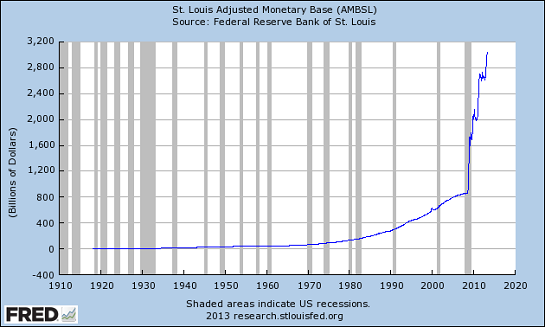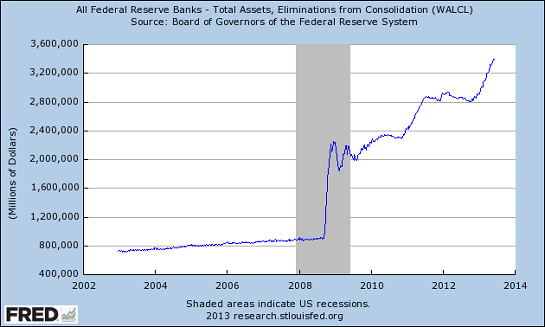And how will the yield curve be affected when the great unwinding actually begins? We have seen the beginning of movement with the usage of the word of 'taper' being tossed out for the financial markets to nibble upon.
These are very interesting times in the financial world and even though we throw around the term 'new normal' to describe this phase of our current economic cycle, the dial on the the risk indicator reflects pressure is building with each passing day.
Since money is now created digitally, it too is basically free. We can see how easy it is to digitally create trillions of dollars in this chart of the U.S. monetary base. Roughly $1.2 trillion was created out of thin air essentially overnight back in the good old days of global financial meltdown:

For another look at the wonders of the digital credit creation machine (a.k.a. digital printing press), here are the assets of the Federal Reserve banks: there's the $1.2+ trillion again--hum, Baby! Hit me with another trillion....

Here's a detailed look at the assets the Fed bought with its digitally created money--mostly Treasury bonds and real estate mortgages:

The key feature of digitally creating credit/money is this: it is immeasurably easier to digitally create claims on real-world assets than it is to create real-world assets.
This is why the digital creation of trillions of dollars in credit/money is distorting and disrupting the real economy of real-world assets: the claims on those assets keep expanding while the actual assets remain stubbornly tied to the real world.
Everything Created Digitally Is Nearly Free - Including Money - Charles Hugh-Smith
It is immeasurably easier to digitally create claims on real-world assets than it is to create real-world assets.
We all understand that the cost of everything that can be created digitally is near-zero. This is why music, videos, text-based knowledge and telephone calls (Skype) are now basically free.Since money is now created digitally, it too is basically free. We can see how easy it is to digitally create trillions of dollars in this chart of the U.S. monetary base. Roughly $1.2 trillion was created out of thin air essentially overnight back in the good old days of global financial meltdown:

For another look at the wonders of the digital credit creation machine (a.k.a. digital printing press), here are the assets of the Federal Reserve banks: there's the $1.2+ trillion again--hum, Baby! Hit me with another trillion....

Here's a detailed look at the assets the Fed bought with its digitally created money--mostly Treasury bonds and real estate mortgages:

The key feature of digitally creating credit/money is this: it is immeasurably easier to digitally create claims on real-world assets than it is to create real-world assets.
This is why the digital creation of trillions of dollars in credit/money is distorting and disrupting the real economy of real-world assets: the claims on those assets keep expanding while the actual assets remain stubbornly tied to the real world.
No comments:
Post a Comment